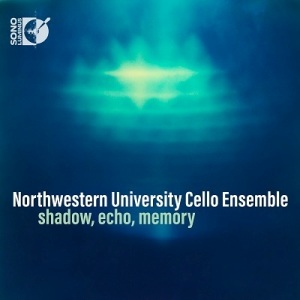A little more than 20 years ago a record label called Cala released a series of discs that featured various single-instrument ensembles–violins, violas, horns, trombones–with participants from different London orchestras performing arrangements of mostly familiar works by famous composers: Saint-Saëns, Rachmaninov, Casals, Dvorák, Ravel, Debussy, Gershwin, etc. The one for cello ensemble, called The London Cello Sound, was performed by 40 cellos, and offered Saint-Saëns’ The Swan, Rachmaninov’s Vocalise, and Casals’ Sardana, among other works. Nothing adventurous, nothing even slightly challenging to the ear–just the smooth, easily listenable, rich, resonant, mellifluous sound of those 40 expertly played cellos playing music you could just sit back and let wash over you, which was the whole point.
Here, although we do get a few nods to similarly romantic repertoire–the same Rachmaninov Vocalise, in addition to Fauré (Après un rêve) and Mahler (Adagietto from Symphony No. 5)–the point seems to be showing the cello ensemble–far more than 40 members, in this case, although not always playing at the same time–as a vehicle for more widely expressive ventures, into the world beyond the easily listenable, the mellifluous, or melodically familiar, giving specific attention to composers associated with the ensemble’s home territory, Northwestern University.
There’s a well-respected and oft-quoted rule in the real estate world, that the three most important criteria in buying or selling are “location, location, location.” A similar rule applies to successful concerts and recordings, only in this case the word is “programming, programming, programming.” And here is where this recording fails, falling into the misguided assumption that the more widely varied the music, the more widely reaching the audience. But why would anyone think that a listener drawn to the opening lovely, lyrical Three Lacquer Prints and Après un rêve–not to mention the later Vocalise and Adagietto–would happily enjoy a sudden jolt into the totally different world of Michael van der Sloot’s Shadow, Echo, Memory, a chaotic, cacophonous, at times amusical venture that on its face makes no musical sense?
In the notes we are told that the work is supposed to represent the composer’s response to the masterpieces found on the walls of prehistoric caves…invoking flickering light, reflections of water, rising smoke, and shifting shadows. Really? The music could just as easily be “about” a thunderstorm, waves crashing on the shore, or a political debate–or nothing. This kind of representational assignment to music is usually just a gimmick; on its own, music is not “about” anything, and if you have to explain what it is supposed to be about, if you can’t tell just from listening, then I make my point. That’s not to say you won’t enjoy this exploration of sound–cello sound, including some effects you’ve likely never heard a cello make; but don’t think you will instantly hear whatever a cave painting sounds like.
There are other forays into the outer reaches of the cello sound world, and it’s interesting that these more extreme explorations are always the longest–van der Sloot’s Shadow, Echo, Memory is almost 10 minutes, and Hans Thomalla’s Intermezzo, an excerpt from an opera (Fremd), is nearly nine. In both cases I have to say that my patience was tested–and as I’ve mentioned in previous reviews, I came of age during the era of Carter, Babbitt, Martino, Goehr, Boulez, etc., and thus can’t be shocked–and ultimately I didn’t appreciate being jerked from the syrupy romantic to the assertively “modern” pieces and back again. It may have seemed a good idea at the time, but cellos reproducing Ligeti’s famed Lux aeterna misses the shimmering energy and vibrant, scintillating, clashing timbres of voices. It’s just kind of boring.
My question for the producers of this CD is, what exactly are you giving me, and why? The Northwestern University Cello Ensemble had some concert recordings (made in 2013 and 2014) and it looks like someone thought they should just dump all of them onto a CD. Nice for the ensemble members, their friends and relatives, but not a harmonious listening experience for the rest of us. I have no complaints about the playing: these cellists are first-class. And the sound, although the recordings were made at different times and venues, is very good. Know what you’re getting into and you won’t be disappointed.
































